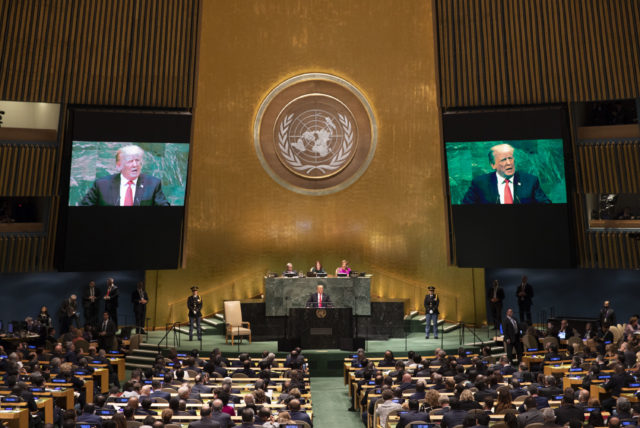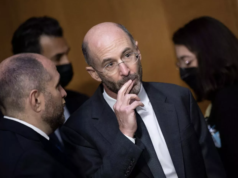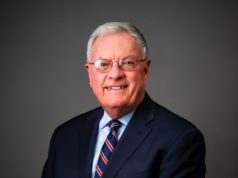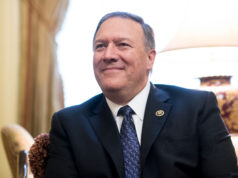
“We remain a nation at war.” President Trump’s new National Strategy for Counterterrorism, released in early October, begins with that simple statement of fact. Despite the West’s victories in the several major wars of the 20th century, the 21st century is not an age of peace. It is yet another age of conflict.
We don’t like that. It’s more comforting to believe, as President Obama asserted on numerous occasions, that “the tide of war is receding.”
For the 44th president, that phrase became both a mantra and an idée fixe following the May 2, 2011 midnight raid by U.S. Navy SEALs on Osama bin Laden’s compound in Abbottabad, Pakistan.
Obama initially used the phrase on June 23, 2011, in his prime-time address from the East Room of the White House, announcing the first phase of U.S. troops’ withdrawal from Afghanistan.
That summer, he released his National Strategy for Counterterrorism, which strongly suggested that the end of what the George W. Bush administration had called the Global War On Terror was imminent. In his introduction to the main text, he wrote: “Today, we can say with growing confidence – and with certainty about the outcome – that we have put al-Qaeda on the path to defeat.”
In September, he told the U.N. General Assembly: “Let there be no doubt, the tide of war is receding.” The phrase also cropped up in Obama’s next State of the Union address, and on half a dozen other occasions.
The evidence for this optimistic analysis was less than conclusive. In addition to the elimination of bin Laden, there was the Arab Spring, widely presumed to herald an anti-authoritarian and pro-democracy turning point in the Middle East. A patina of stability in Iraq provided justification for Obama’s decision to pull the U.S. military out of that troubled land. The Taliban appeared to be on the defensive in Afghanistan.
At that point, the bloodbath in Syria had barely begun. A year would pass before the murder of a U.S. ambassador in Benghazi highlighted the chaos in Libya. The Islamic State had not yet risen from the ashes of al-Qaeda in Iraq, which had been decimated by the “surge” President Bush ordered with Gen. David Petraeus in command.
And when the Islamic State did arise, early in 2014, Obama dismissed it as a “JV” team. The following year, just before IS terrorists carried out a massacre in Paris, he insisted that, “we have contained them.”
In the early days of his second term, Obama sought to formalize the end of the war by seeking to repeal the Authorization for Use of Military Force (AUMF) that Congress passed in 2001. “This war, like all wars, must end,” President Obama told his audience at the National Defense University. “That’s what history advises. That’s what our democracy demands.”
Actually, if history advises anything it’s that wars seldom end by fiat. Nor do most wars simply grind to a halt. Instead, they are won or lost. “Conflict resolution” is a fine notion but it often conceals a hiatus during which at least one side prepares for the next round of conflict (cf. World War I and World War II). As for democracy, it demands vigilance when confronted with anti-democratic forces. Of which there are many.
Fighting Radical Islamists
In World War II America defeated racial supremacists. In the Cold War we defeated class supremacists. In the current war, the Long War, as it makes sense to call it, we face religious supremacists whose theology rules out peaceful coexistence. The Obama administration never grasped this stark reality.
The Trump administration appears to. At a White House briefing, National Security Advisor John Bolton told reporters the principal difference between the new strategy and its predecessor is that the former “recognize[s] that there’s a terrorist ideology that we’re confronting.” “Without recognizing that we’re in an ideological struggle,” Bolton added, “we can’t properly address the terrorist threat.”
To be fair, the previous administration favored a “war of ideas.” Indeed, it asserted that it was prevailing in this theater.
“The relevance of al-Qaeda and its ideology has been further diminished,” Obama wrote in his introduction to the 2011 document. The Arab Spring, he added, had discredited the terrorists’ ideology by showing how, “In just a few short months, [non-violent] movements achieved far more political change than al-Qaeda’s years of violence.”
In fact, as is now apparent, under Ayman al Zawahiri, successor to bin Laden, al-Qaeda merely evolved. And it has continued to grow. At the same time, tens of thousands of young men, and more than a few young women, left behind relatively safe and comfortable lives in Europe, the Gulf States, and North Africa to answer the Islamic State’s call to establish a new caliphate in Syria and Iraq. They did this in the belief that they were fulfilling their religious duty.
The 34-page strategy issued by the Trump administration refers to “radical Islamist terrorist groups,” a phrase President Obama avoided out of fear it would offend Muslims and validate the terrorists’ claim to represent authentic and original Islam.
President Obama was misguided. Muslims are not fools. They know that from Asia to the Middle East to Africa to the Balkans to Michigan, Islam is interpreted and practiced in many different ways.
Islam is not a monolith. However, a fanatic minority of Sunni Muslims are determined to make it one – determined to eliminate what they see as heretical practices and interpretations of Islamic scripture. Day after day, they slaughter Muslims who disobey or even disagree. The Arabic word for such a theological bully: takfiri. We can and should ask Muslims to stand up to them. Indeed, we have an obligation to support those who do.
In the briefing at which he introduced the new strategy, Amb. Bolton noted that, “King Abdullah of Jordan has frequently described the terrorist threat as a civil war within Islam.”
Mr. Trump’s new strategy distinguishes Islam, the faith of more than a billion people around the world, from Islamism, an ideology committed to spreading a supremacist, intolerant and bellicose version of Islam and of Islamic law. Islamists seek to re-establish the dominance Islam enjoyed throughout much of the world for nearly a thousand years.
Not all Islamists utilize violence – which is not the same as saying they reject violence. A subset of Islamists, however, may be described as jihadists. They believe, as a matter of faith, that the path to the future must be cleared by the sword, by waging a holy war to defeat and eliminate infidels, apostates, and heretics. Or, as al-Qaeda leader Ayman al-Zawahiri phrased it a message timed to coincide with the most recent anniversary of the 9/11/01 attacks, against “the major international criminals – America being the foremost.”
Iran’s rulers, though Shiite, not Sunni, are indisputably jihadists. The Trump strategy characterizes the Islamic Republic as “the most prominent state sponsor of terrorism, through its global network of operatives and its ongoing support to an array of terrorist groups.”
The relationship between radical Islamists of the Sunni and Shiite varieties is complicated. Sunni takfiris view Shiites as their enemies but they are quite willing to deal with devils when doing so seems useful. By the same token, Shiite jihadists hate takfiris – whom they accuse of being an American creation – but are more ecumenical about Sunnis in general.
In his White House briefing, Amb. Bolton remarked that the theocrats in Tehran have been “the world’s central banker of international terrorism since 1979,” adding that “Iran-sponsored terrorist groups such as Lebanese Hezbollah, Hamas, and Palestinian Islamic Jihad continue to pose a threat to the United States and our interests.”
It is worth noting that Hamas and Palestinian Islamic Jihad are both Sunni radical organizations, which are glad to work hand-in-glove with the Shiites in Tehran. Also, Bolton was not waxing rhetorical when he described the Iranian regime as the central banker of international terrorism. In May, the U.S. Treasury imposed sanctions on the governor of the Central Bank of Iran for his personal role in helping to fund Hezbollah.
War by Other Means
Successfully fighting wars requires staying on a war footing for as long as necessary. It means killing enemies. Amb. Bolton said the president also intends to place “an increased emphasis on non-kinetic means.” The document candidly acknowledges, however, that, “we have not developed a prevention architecture to thwart terrorist radicalization and recruitment.”
In general, the Trump administration has been dismissive of the various programs initiated by its predecessor in the name of countering violent extremism, even those based on credible approaches to preventing radicalization. This is a situation that it might be helpful to reexamine.
Among the non-kinetic approaches, per the new strategy, is to “dismantle terrorists’ networks and sever the sources of strength and support that sustain them, that allow them to regenerate, and that permit them to adapt.”
In other words, the use of economic weapons will be integral to depriving both Iran’s rulers and non-state terrorist groups of the resources they need to fight effectively over the long run. The U.S. Treasury has developed mechanisms to disrupt terror financing.
The Trump administration has indicated it will exert far greater financial pressure on Iran’s rulers. Obama started lifting that pressure in exchange for an interim nuclear weapons agreement in 2013, which the parties finalized two years later. Pressure also will be increased on Iranian-backed Hezbollah. Obama let Hezbollah get up from the mat when he dismantled Project Cassandra, the formidable interagency task force dedicated to disrupting the globe-spanning criminal enterprise that Hezbollah runs to finance its operations.
Terrorist funding also continues to come from Middle Eastern petroleum—the most important source of income for Tehran. The administration would be well-advised to implement policies to encourage transportation fuel diversification which can lead to increased U.S. energy security, if not independence. The day before the White House released Trump’s new strategy, the price of Brent crude hit a four-year high of more than $86 per barrel, with analysts forecasting $100 per barrel in the near future.
The price has tumbled since then, thanks in part to Saudi Arabia’s efforts to maximize production. Yet a Saudi bailout may not always be a viable option, for both political and economic reasons.
Another means of ensuring the economic sustainability of the U.S. counter-terrorist strategy is to find partners willing and capable enough to share the burden. The administration would like America’s allies to be better partners, to shoulder more responsibilities. “America First does not mean America alone,” the new strategy notes.
Burden-sharing has been a perennial objective, dating back to George W. Bush’s inaugural National Strategy for Combating Terrorism, released shortly before the invasion of Iraq in 2003. As the history of NATO suggests, the search for an equitable division of labor never ends. Thankfully, in the struggle against the Islamic State, the U.S. partnership with Syrian Kurdish forces has proven to be extremely beneficial, first under Obama and then under Trump.
Other notable components of the Trump strategy include continuing to detain unlawful combatants at Guantanamo (once on American soil they would be legally entitled to all the rights of American citizens), “building strong borders, strengthening security at all ports of entry into the United States, protecting its critical infrastructure, and facilitating preparedness.”
At this moment, the U.S. electrical grid is vulnerable to cyber weapons as well as an EMP attack (the detonation of a nuclear weapon high above the U.S. mainland). Prevention is preferable to cure but we should have a backup plan, one that makes it possible to restore electric power within days, not months.
President Trump’s new strategy is not the last word on counter-terrorism. Our enemies learn and adapt. So must we. Military strategists for millennia have been counseling that, “If you know the enemy and know yourself, you need not fear the result of a hundred battles.” With the tide of war rising rather than receding, that’s a conservative estimate of the number of battles that lie ahead.
Clifford D. May is president of the Foundation for Defense of Democracies (FDD), where David Ades-nik, Ph.D., is the Director of Research.





